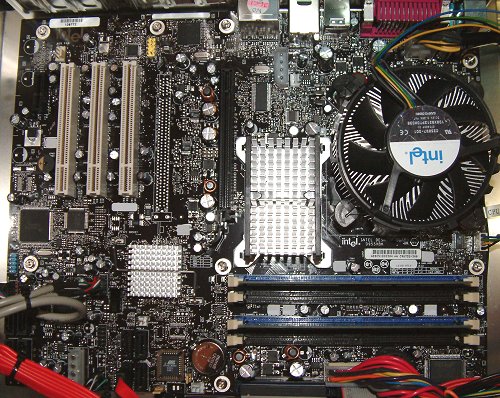955X Express
Mating up with the Pentium Extreme Edition 840 is a new core logic. Initial announcements at the Intel Developer Forum (IDF) hinted that the 955X Express chipset would feature dual bridged X16 PCI-Express graphics lanes for NVIDIA-like SLI performance. That's not the case with the pre-production Intel D955XBK reference motherboard, codenamed Black Creek, anyway. Intel assures us that all production boards will have 2 X16 graphics lanes.
The supplied motherboard, as you can see, is a regular ATX board. Intel also plans to launch a BTX version, codenamed Chisholm Trail, in the near future.
The 82955X Memory Controller Hub acts as a conduit between processor and system memory running at up to DDR2-667 speeds (10.7GB/s). Considering that the D955XBK is ratified to run with a 266MHz system bus speed, it's all the more perplexing as to why Intel chose a 200MHz CPU bus speed. Surely a dual-core Extreme Edition deserves the bump up to the single-core's 266MHz? As usual with Intel's premier desktop chipset, the 955X sports both ECC memory support and PAT-like optimisations for faster access. Quad-threading support for the Pentium Extreme Edition 840 and 8GB memory addressability are also implemented features.
955X Express is also new from a southbridge point of view. Debuting here is Intel's ICH7R, which builds on current Intel desktop chipsets' Matrix Storage Technology by offering onboard RAID0, 1, 5, and 10 (0+1). The first two and last will be familiar to most readers. RAID5, however, uses at least 3 disk drives and stripes data across them. Additionally, all drives in a RAID5 formation have parity bits (shared information about what's on each drive), so that if a disk fails, other drives making up the RAID array can reconstruct the data without error, assuming the parity was correct before disk failure. It's better but slower than the similar RAID4 by not having all parity information on a single drive (imagine if that went down!)
Intel has also beefed-up SATA support by offering 4 SATA-2 ports. Each port is rated at 3GB/s (translates to 300MB/s data rate), double that of SATA-1's 1.5GB/s (150MB/s). This kind of increase looks all dandy on paper, but how many devices can currently breach SATA-1's speed limit? Native Command Queuing, as you'd expect, is also present on this model. 955X Express specifications also allow motherboard manufacturers the opportunity to graft on up to 6 X1 PCI-Express and 6 PCI slots, but we expect most to go with the present 3 each found on most high-end 925X(E) boards. Carried on over from the current feature-set on the incumbent ICH6 southbridge is Intel's decent high-definition audio and 8x USB 2.0 ports.
The 945X model is targeted to be paired with non-HT-equipped Pentium D processors for mid-to-high-end performance. We will see Intel introduce its newest iteration of onboard graphics, the GMA950, and if recent history is anything to go by, 945X chipset-based boards will be adapted by most major board manufacturers to provide low-cost entry into dual-core computing. 955X Express boards, on the other hand, will be stacked with all the features goodies (and high price tag) of top end 925XEs.









